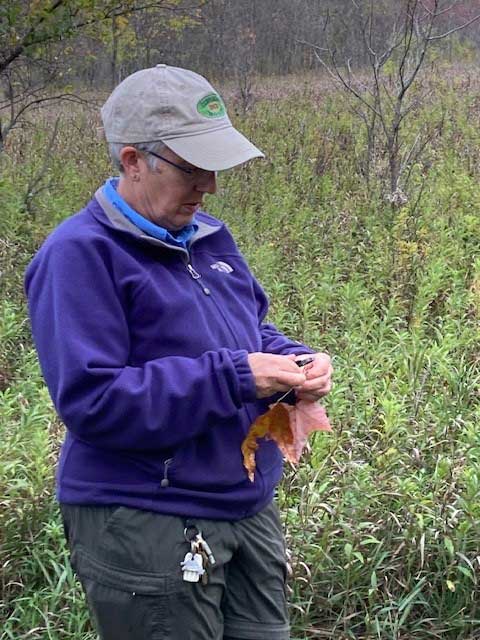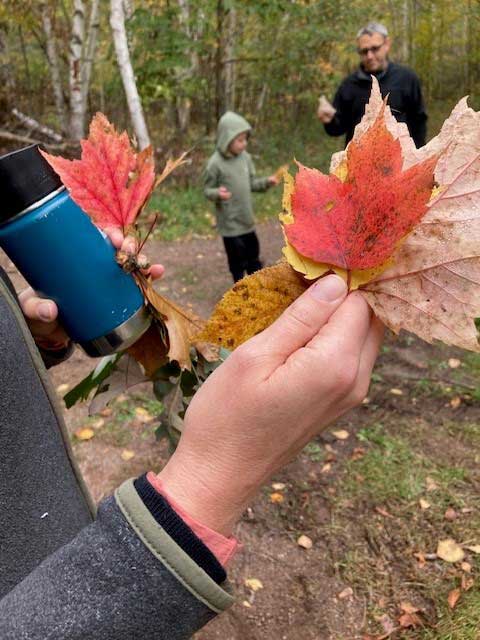Adventures At Wild River State Park – A Fall Hike Reveals The Mysteries Of Fall Leaf Color
By Deborah Locke, DNR Information Officer
To anyone encountering our small group at Wild River State Park recently, you would have thought, how nice. Happy people out for a simple walk. Adults with children, zipped up jackets, a park naturalist talking away.
But it wasn’t that simple, during the mile-long loop hike past thousands of fallen leaves. It was a mini-botany class on the biology of a leaf, taught by park naturalist Sean Hoppes. Naturalists have dual jobs, both educating the public about the outdoors, and conserving and protecting Minnesota’s amazing natural resources. They are trained experts on a lot of subjects, and when you’re with them, they notice everything you might miss.
On that Saturday morning as we walked, Sean told the group to pick up different shapes of colorful leaves. He explained the science of leaf growth from bud to full leaf, which involves water and chlorophyll. He then showed how a plant dissolves a part of its own stem so the leaf can fall to the ground, demonstrating with perforations on a sheet of paper. Park visitor Noah Vargas, 7, found that explanation so compelling that he’s repeated the mini lesson often since the hike.
“He loved those hands-on learning moments,” said his dad, Joseph Vargas of Ostego. The dad and son usually camp in an RV, but that weekend, pitched a tent. Also, it was their first-ever naturalist program. Joseph said he was impressed with Sean’s enthusiasm for his subject, and the way the hike was structured with frequent stops.
There are other benefits than education for attending a naturalist program at a Minnesota state park. Wild River campground host and fellow hiker Pat Graham said that being outdoors is calming and peaceful and gives opportunities for exercise. (Campground hosts are unpaid volunteers who camp at parks for a month each camp season and help visitors and staff.) Pat, who has a degree in natural resources management and completed the Master Naturalist program, knows the life cycle of leaves. But she attended the program anyway to see Sean in action.
A simplification of leaf color change is this: as the summer grows old, less green color-producing chlorophyll is produced in leaves. Without chlorophyll, the bright orange, red, and yellow pigments are left. If a tree doesn’t receive enough water due to a drought, like this year, leaves on certain tree species are less vibrant. On the day we walked, Sean pointed out that the only variation in colors was from yellow to various shades of green. No gold or red appeared. We passed a damaged tree from a July storm that was full of crusty brown leaves. Those leaves were still firmly attached because the tree didn’t go through the usual stages of leaf shed and instead, suffered a traumatic end, Sean said.
As for the walk itself, it started down a steep hill which means it ended with a steep climb back up to the Visitor Center and parking lot. Let’s say the climb was invigorating. If you decide to participate in a state park hiking program, call ahead to see what the terrain offers or check the online park map.
Also, driving directions may take you to a park entrance, but that’s all. The visitor center could be an additional three miles into the park. I left a half hour early for Wild River State Park, which paid off in the end.
Finally, dress for the weather, wear sturdy shoes with rubber soles, and know that you’ll return home with more than new knowledge. Pat Graham had it right: time outside moving around does calm the spirits and sooth the soul. Take family members and/or friends along. Like Noah, you too may learn something worth sharing with others for a long, long time.
To see a list of state parks, go to mndnr.gov/parkfinder. For a listing of state parks and trail programs, go to mndnr.gov/ptcalendar. Most programs are free and do not require pre-registration. The $7 daily or $35 annual state park vehicle permit can be purchased online or at the park entrance office. Plan for extra time with other park amenities. For example, Wild River State Park recently completed work on new visitor center exhibits.









